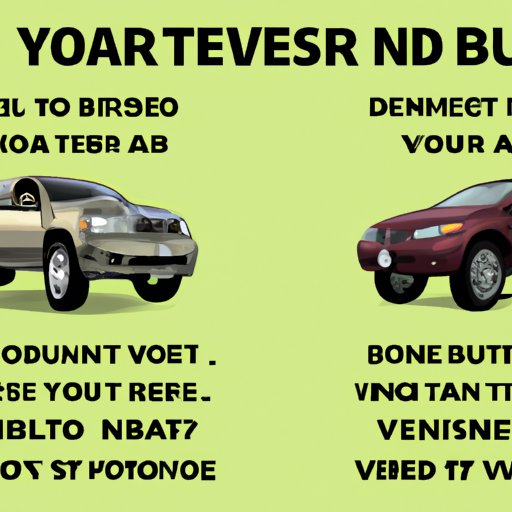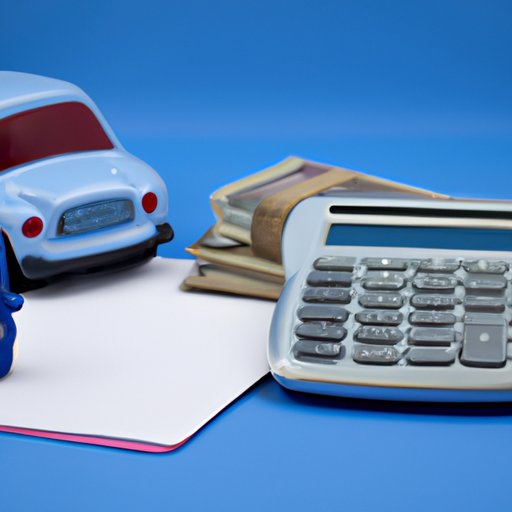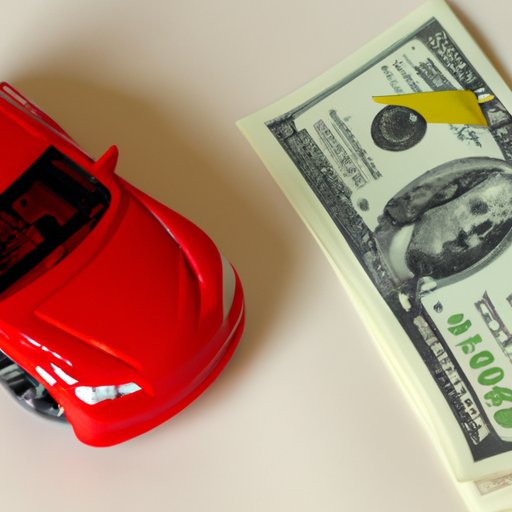Introduction
Buying a car is a major purchase, so it’s important to know how much you can afford to spend. It’s easy to get caught up in the excitement of shopping for a new car, but if you don’t take the time to assess your financial situation and set a realistic budget, you could end up spending more than you can afford. In this article, we’ll explore how to determine your budget for a car purchase, as well as tips for sticking to that budget and strategies for saving money.
How to Determine Your Budget for a Car Purchase
Before you start shopping for a car, it’s important to do some research and figure out how much you can realistically spend. Here are some key steps to take when budgeting for a car purchase.
Analyzing Your Financial Situation
The first step is to take a close look at your finances. Start by assessing your income and expenses. Figure out how much money you have coming in each month, and how much you’re spending on bills, groceries and other essentials. Once you’ve done this, you’ll have a better idea of how much you can reasonably dedicate to a car payment each month.
Calculating the Cost of Vehicle Ownership
It’s also important to consider the costs associated with owning a car. According to a study by AAA, the average cost of vehicle ownership is $8,469 per year, or about $706 per month. This includes things like fuel, maintenance, insurance and depreciation. Keep these costs in mind when setting your budget.
Setting Your Maximum Budget
Once you’ve analyzed your financial situation and calculated the cost of vehicle ownership, you can set a maximum budget for your car purchase. It’s best to err on the side of caution and choose a budget that’s slightly lower than what you can afford. This will give you some wiggle room in case there are any unexpected expenses.

Tips for Sticking to Your Car Budget
After you’ve set your budget for a car purchase, it’s important to stick to it. Here are some tips for staying within your budget.
Making Sacrifices and Cutbacks
If you find yourself struggling to stay within your budget, you may need to make sacrifices and cut back on some of your expenses. Consider reducing your eating out budget or cutting back on entertainment expenses. This will give you extra cash to put towards your car purchase.
Shopping Around for the Best Deals
When shopping for a car, it pays to shop around. Compare prices at different dealerships and online. You may be able to find a better deal if you’re willing to do some legwork. Also, don’t forget to check out special offers and discounts.
Finding Creative Ways to Save Money
There are lots of creative ways to save money on a car purchase. For example, you could opt for a used vehicle instead of a new one, or look for cars with higher fuel efficiency ratings. You could also consider financing options, such as zero-interest loans or lease programs.
Calculating the Total Cost of Ownership for Your Car
In addition to the upfront cost of the car, you’ll also need to factor in the total cost of ownership. This includes things like fuel, maintenance and insurance costs. Here’s how to calculate the total cost of ownership for your car.
Factors to Consider When Calculating the Cost
When calculating the total cost of ownership, you’ll need to consider several factors. These include the purchase price of the vehicle, fuel costs, maintenance costs (such as oil changes and tire rotations), insurance premiums, registration fees and taxes.
Estimating Fuel, Maintenance and Insurance Costs
To estimate fuel costs, consider how many miles you’ll be driving each month and how much gas costs in your area. For maintenance costs, you can use the manufacturer’s recommended service schedule to estimate how much you’ll be spending on things like oil changes and tire rotations. And for insurance costs, you can get quotes from different insurers to get a better idea of what you’ll be paying.

The Benefits and Drawbacks of Buying a New vs. Used Vehicle
When shopping for a car, you’ll need to decide whether to buy new or used. There are pros and cons to both options, so it’s important to weigh your options carefully.
Comparing Quality, Reliability and Resale Value
One of the main advantages of buying a new car is that it will generally be of higher quality and have better reliability than a used car. Additionally, new cars tend to have higher resale values than used cars. However, they also tend to be more expensive.
Examining Warranty Coverage and Other Perks
New cars often come with warranties that cover certain repairs and maintenance costs. This can help reduce the cost of ownership over time. Additionally, some automakers offer additional perks, such as free roadside assistance or complimentary oil changes. On the other hand, used cars may not come with these benefits.
How Financing Can Impact Your Car Budget
If you’re planning to finance your car purchase, it’s important to understand how financing can affect your budget. Here’s what you need to know.
Understanding Interest Rates and Loan Terms
When financing a car, you’ll need to consider interest rates and loan terms. Interest rates can vary significantly from lender to lender, so it pays to shop around for the best deal. Additionally, it’s important to understand the loan terms you’re agreeing to, such as the length of the loan and the amount of the monthly payments.
Evaluating Different Types of Car Loans
There are several types of car loans available, including traditional loans, leases and dealer financing. Each option has its own pros and cons, so it’s important to evaluate them carefully before making a decision. For example, leasing a car may require lower monthly payments, but you won’t build equity in the vehicle.
Advice on Managing Your Debt
Finally, it’s important to manage your debt responsibly. If you’re taking out a loan to finance your car purchase, make sure to pay your monthly payments on time. Additionally, try to pay off the loan as quickly as possible to reduce the amount of interest you pay.

What to Consider When Shopping for a Car With a Limited Budget
When shopping for a car with a limited budget, it’s important to prioritize needs over wants. Here are some tips for finding a car that fits your budget.
Prioritizing Needs Over Wants
When shopping for a car, it’s important to focus on the features you need rather than the ones you want. Make a list of must-have features and look for cars that meet those criteria. This will help you narrow down your search and make it easier to find a car that fits your budget.
Researching the Market for Bargains
Another way to save money is to research the market for bargains. Look for sales, promotions and discounts that can help you get the car you want at a lower price. Additionally, consider looking for cars that have been certified pre-owned, as these can offer significant savings.
Comparing Prices Online and In-Store
Finally, it’s important to compare prices both online and in-person. Shopping online can help you find great deals, but it’s also worth taking a trip to a local dealership to see what kind of deals they’re offering. That way, you can get the best of both worlds.

Strategies for Saving Money on a Car Purchase
In addition to shopping around for the best deals, there are other strategies you can use to save money on a car purchase. Here are some tips.
Taking Advantage of Cash Discounts
If you’re paying cash for your car, you may be able to get a discount. Many dealerships offer discounts to customers who pay in full up front. This can help you save money on the purchase price of the car.
Negotiating with Dealerships
Another way to save money is to negotiate with dealerships. Don’t be afraid to haggle over the price of the car. The worst they can say is no, and you may be able to get a better deal if you’re willing to bargain.
Exploring Trade-In Options
Finally, if you already have a car, you can save money by trading it in. Many dealerships will offer you a trade-in value for your old car, which can help reduce the cost of your new car. Be sure to research the value of your car before negotiating with the dealership.
Conclusion
Figuring out how much you can afford to spend on a car is an important step in the car-buying process. By taking the time to assess your financial situation, calculate the cost of vehicle ownership and set a realistic budget, you can ensure that you don’t spend more than you can afford. Additionally, there are plenty of strategies you can use to save money on a car purchase, such as shopping around for the best deals and taking advantage of cash discounts. By following these tips, you can make sure you get the best deal on your next vehicle purchase.
(Note: Is this article not meeting your expectations? Do you have knowledge or insights to share? Unlock new opportunities and expand your reach by joining our authors team. Click Registration to join us and share your expertise with our readers.)
